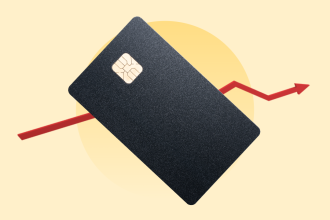If you’ve recently found out your credit score falls into the “fair” range — typically between 580 and 669 for FICO scores and 601 to 660 for VantageScore — you’re likely wondering exactly what this means and how it may impact your finances. Luckily, fair credit is better than poor credit. However, it’s still far from the good and excellent ranges.
Fair credit may limit your financing options and make qualifying for the best interest rates and loan terms harder. However, with discipline and a few smart strategies, you can build your credit score and eventually access better financial opportunities.
What is a fair credit score?
As of March 2024, the average FICO credit score in the U.S. is 717. This places it solidly within the good credit range. In contrast, a fair FICO credit score ranges from 580 to 669, which is 48 points below the national average.
Some lenders use VantageScore instead of FICO scores. While they work similarly, the ranges are not the same. The average VantageScore across the U.S. is currently 705. A “fair” VantageScore, which is known as “near prime” falls between 601 and 660 — 45 points below the average. So, while fair credit might sometimes be called “average credit,” it’s still below the actual average credit score in America, regardless of whether you’re referring to a FICO score or VantageScore.
Out of about 225,000 Bankrate users who requested credit card matches on the site in 2023, just over 21 percent fall into the fair credit score range.
Having a fair credit score often means you won’t qualify for the best credit cards and loans since lenders view people with fair scores as riskier borrowers than those with good or excellent credit. There certainly are credit cards for people with fair credit and you can even qualify for some loans, but you’ll want to improve your credit score for the best cards and loan terms. Everyone’s credit history is different, but if you have a fair credit score, you’re likely dealing with one or more of these factors:
What is the range of credit scores?
Your credit score range is based on the information in your credit history. FICO, the most commonly used credit scoring model, categorizes scores into five ranges:
- Exceptional: 800-850
- Very Good: 740-799
- Good: 670-739
- Fair: 580-669
- Poor: 300-579
VantageScore categorizes scores as follows:
- Super-Prime: 781-850
- Prime: 661-780
- Near-Prime: 601-660
- Sub-Prime / Not Prime: 300-600
What causes a fair credit score?
A fair credit score can happen for a variety of reasons. While everyone’s credit history is different, if you have a fair credit score, you’re likely dealing with one or more of these factors:
- A late or missing payment
- An account in collections
- Credit report errors
- Limited credit accounts
- High credit utilization
- Excessive hard inquiries
- Shorter credit history
It can be hard to know exactly what’s impacting your credit score without reviewing your credit report, but tackling these issues may help boost your score.
Fair vs. good credit
Fair credit and good credit are next to each other on the credit score scale, but your financial opportunities get significantly better once you pass the threshold of a 670 score. The difference between fair credit and good credit goes beyond which score range you’re in — it affects your approval odds for credit cards and loans, how much you’ll pay in interest and even what your monthly payment is on certain debts.
For example, if you were planning to buy a new car for $30,000 with a 36-month auto loan in California, you’d pay significantly more for the same loan with a fair credit score of 600 than with a good credit score of 700. Let’s take a look at the difference:
| Good Credit (700) | Fair Credit (600) | |
|---|---|---|
| Monthly payment | $949 | $1,050 |
| APR | 8.36 percent | 15.67 percent |
| Total interest paid | $4,161 | $7,798 |
| Source: MyFICO Loan Savings Calculator | ||
If you had a fair credit score of 600, you would pay $101 more each month and a total of $3,637 more in interest over the three-year loan term. Bumping your credit score up by 100 points and into the “good” credit category brings your interest rate down from an estimated 15.67 percent to 8.36 percent, according to the interest rates available on March 28, 2024.
On the same note, credit cards for people with good credit typically offer higher rewards, lower interest rates and better perks. With good credit, you’ll also have access to more credit card options.
Data point
If you’re in the fair credit range, you’re already better off financially than those with poor credit, but you shouldn’t stop there. One of the best things you can do for yourself is take steps to improve your credit as quickly as possible.
What cards can I apply for with fair credit?
Many of today’s best rewards credit cards are only available to people with good or excellent credit. But that doesn’t mean you’re out of luck if your score is in the fair range. There are numerous cards for people with fair credit that still provide worthwhile benefits and perks. For example, here are two cards we recommend:
-
The Capital One QuicksilverOne Cash Rewards Credit Card is a flat-rate cash back credit card offering unlimited 1.5 percent cash back on your everyday purchases and 5 percent back on hotels and rental cars booked through Capital One Travel. This card comes with a $39 annual fee, but it includes two key benefits: You can use Capital One’s CreditWise tool to monitor your credit score and, with responsible use, you’ll be automatically considered for a higher credit line after six months of on-time payments.
-
The Discover it® Secured Credit Card, is another cash back rewards card specifically designed to help you build your credit history and boost your credit score with responsible use. Since it’s a secured credit card, you’ll need to put down a refundable security deposit of at least $200 to establish your credit line. After seven months, Discover will review your account and determine whether you qualify to have your security deposit returned and be upgraded to an unsecured line of credit.
As you use your Discover it® Secured Credit Card, you’ll earn 2 percent cash back at gas stations and restaurants on up to $1,000 in combined purchases each quarter (then 1%) and 1 percent cash back on all other purchases. Plus, you’ll get to reap the benefits of Discover’s Cashback Match program, which matches all the cash you earn in your first year as a cardholder. You can also view your free credit scorecard with your FICO Credit Score when you log into your Discover account or use the mobile app — so you can check your score regularly and watch it improve.
Bankrate’s CardMatch tool
Don’t want to run endless hard credit inquiries to find a credit card for fair credit? Use Bankrate’s CardMatch tool to prequalify for a card that fits your needs without affecting your credit score.
Compare top cards
How to improve a fair credit score
While having a fair credit score is better than having bad credit, there’s still plenty of room for improvement. If you’re looking to bump your score to the good or even excellent ranges, start with these tips:
- Make all your credit card payments on time. The largest factor impacting your credit score is your payment history. This accounts for 35 percent of your FICO score, so avoid late payments whenever possible. If you accidentally miss a payment, try to pay it off before it becomes 30 days past due. Catching up quickly will keep your late payment from being reported to the three credit bureaus.
- Keep your balances as low as possible. Your credit score is also largely based on your credit utilization rate — the amount of credit you’re using compared to the amount of credit available to you. This makes up 30 percent of your FICO score. By keeping your balances low or paying them off in full, you’ll decrease your credit utilization ratio and increase your credit score.
- Increase your available credit. Believe it or not, you can boost your credit score by requesting a credit limit increase or applying for a new credit card. If you have more credit available to you — and if you avoid turning that new credit into new debt — your credit utilization ratio will go down and your credit score should go up.
- Check your credit reports for errors. According to a 2024 report released by Consumer Reports and WorkMoney, 44 percent of Americans who checked their credit reports found at least one error. Inaccurate information could be dragging your credit score down. Check your Experian, Equifax and TransUnion credit reports regularly and dispute any errors you find.
As you continue to use credit responsibly — by making on-time payments every month and paying off your balances as quickly as possible — you should see your credit score improve over time. In fact, depending on where you are in your credit-building journey, you could see significant improvement in just a few months.
The bottom line
Having a fair credit score means you’re in a better position than those with poor credit, but there’s still work to be done to reach the good or excellent ranges. A fair score can limit your choices for loans and credit cards and often results in higher interest rates.
A fair credit score isn’t a dead end. There are still viable credit options available, and with some effort and strategic financial habits, you can qualify for credit and improve your score over time. Eventually, that credit boost may open doors for you, giving you access to a wider range of financing options and greater financial flexibility.
Read the full article here














